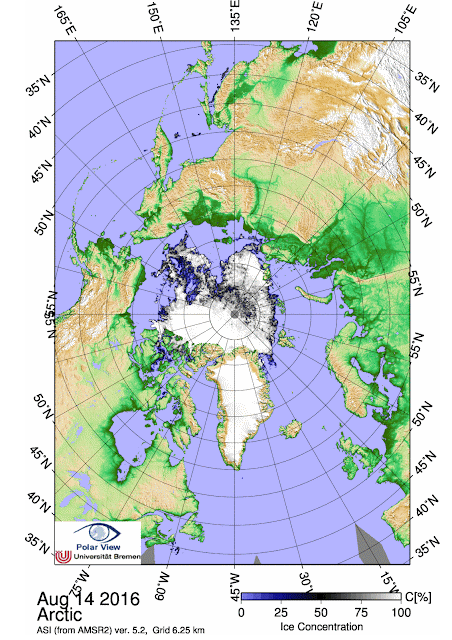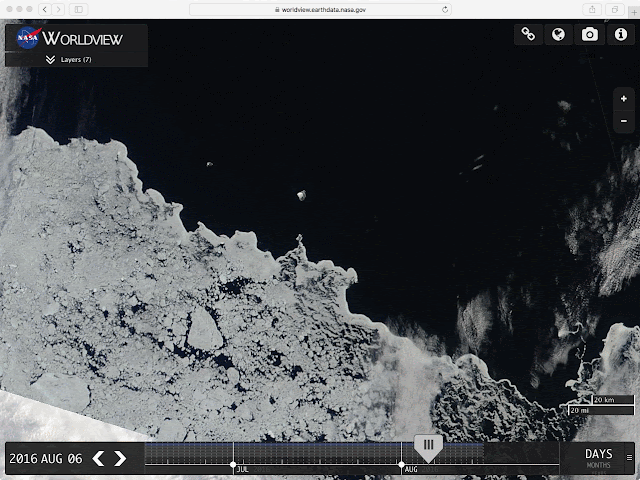Here we fall into the 15% sea ice minimum extent per grid delusion, which in effect even the best system does not capture the holistic picture, by set of standard rules. We must always combine all data sources possible to obtain the holistic construct to have a better understanding of reality. Unlike 2013, 2016 exceeded the 85% threshold for open water. 2013 had much more ice density despite North Pole area pack Ice being flooded with open water, perhaps if the grid was made smaller, 2013 would show up somewhat worse than historically presented. WD august 23,2016
Monday, August 22, 2016
North Pole Sea ice: what we can see 2016 is bad, 2013 visually worse, but 2016 is it
Here we fall into the 15% sea ice minimum extent per grid delusion, which in effect even the best system does not capture the holistic picture, by set of standard rules. We must always combine all data sources possible to obtain the holistic construct to have a better understanding of reality. Unlike 2013, 2016 exceeded the 85% threshold for open water. 2013 had much more ice density despite North Pole area pack Ice being flooded with open water, perhaps if the grid was made smaller, 2013 would show up somewhat worse than historically presented. WD august 23,2016
Compaction vs scattering, sea ice movement favours some extent gains on the leeward side until spreading gets water to be prominent.
August 20-21 JAXA sea ice extent map, has a particular feature of interest. Sea ice extent drop was largely diminished on 21 august, despite larger sea water areas. Note the rotation of the remainder ice pack. Notice stable sea ice shores on the wind compaction side, but the leeward side is scattered and badly broken, there is no ice to stop movement but sea water, the ice spreads out and gains overall extent amidst water not exceeding 85% coverage per grid. Test this out by placing your mouse cursor on the leeward and windward shore lines. There are significant gains in extent with badly broken up sea ice vs compacted areas almost apparently not rotating counterclockwise. Extent figures will eventually drop much further when the scattering isolates the loosened ice pans further for melting in warmer water. WD August 21,2016
Sunday, August 21, 2016
Towards the left, captures file.
~"to the right" of wind direction- -+ sea ice dispersion is not easily captured.
~ here we have "to the left" compaction by GAC2
Despite clouds large ice pans were moving to the centre of GAC2 2016. Winds go from top to bottom of frame. Located just NW of Banks Island Canada, Sea ice is converging towards centre of the Cyclone. WDAugust21,2016
~ here we have "to the left" compaction by GAC2
Saturday, August 20, 2016
2016 signature characteristic: Sea ice floes not moving very fast
JAXA latest 44,840 km2 apparently daily drop of August 20, did not come as a surprise, a new GAC seen here elegant and spinning a storm, lets call it GAC2, is relishing the temperature contrasts between open water and sea ice air. This NOAA satellite capture, 4 hours apart from the first frame (1450-1856UTC), shows an intense see-through cyclone, see-through because it was largely over sea ice while dragging extremely slowly a lot of loose floes readily available, you can notice the largest ones barely moving by placing your mouse cursor over them. This has been a main feature of 2016 season, the Gyre current has been stubbornly opposite to the winds often, even very strong winds. But there is a daily movement at variance with winds and other geophysical motion vectors nevertheless, largely captured on JAXA maps featured almost daily here. Today, North of Beaufort open water is getting more sea ice, not broken up the same way as with GAC1. Therefore the extent rate slow down, a signal from a weather circulation variation, what comes next is another huge drop.WDAugust 21,2016
Friday, August 19, 2016
Challenge to #1 minima, Sea Water conquering by dividing, fraying sea ice at the edges
There is a huge amount of scattered shattered sea ice, nearly about 1/3 of the remaining pack has loose fluid cover, if it all goes to water, minima would be a dead heat contest with 2012. It is no longer a top 3 year, but currently it is within top 2, 2016 is in virtually same extent tie to 2007 as I write. The Wrangel Island panhandle is almost completely frayed, and should all melt in the coming weeks. The sea water lakes near the Pole can only expand further from a significantly new Cyclone to come. Extent drops will soon be all time highest for days. August 18 84,635 km2 loss is only second to 2015. This brings the matter of autumnal cooling, which no doubt will arrive delayed due to all the open water everywhere. This greater area of sea water has profound implications to Arctic temperatures, the making of winter itself should be later. wd august 19,2016
Thursday, August 18, 2016
2nd day GAC, North Pole situation looks more open than ever
~Sea ice rotation "to the right" of winds, does not show up so well, scattering seems more isobaric
~ Melt rates vary in steps associated with Low pressure movement.
~ Melt rates vary in steps associated with Low pressure movement.
CMC GAC yesterday august 16 at 18 UTC
CMC August 17 18 UTC surface analysis. 981 mb situated 82N 150E not moving Southwards anymore from this time , at 00 UTC the centre was 82N 155E, 983 mb. This means that a new batch of sea ice was broken up further and or at different locations since yesterday. Note the isobars, and look at the rotation of the entire sea ice pack carefully:
JAXA Map Clearly shows very little outward dispersions, but very much sea ice movement following Isobaric lines more closely. The centre of the Cyclone stayed long enough at 86N to cause extensive water zone not readily filling up with scattered ice. You can even notice the isobaric lines etched in sea ice just South of the Pole towards Alaska and Bering Strait. The new Low pressure centre has dragged a new batch of sea ice along the Ostrov Komsomolets Eastern ice bridge shore to cover open water, this accounts for a reduction in extent daily drop to 73,373 km2 (3rd greatest melt for aug 17 since 2002). Note the great scattering of sea ice along Wrangel Island 'pan handle' Eastern shores, surely will give great extent drops in the coming days. The rotation of the entire pack also affects the Atlantic sea ice front, bringing sea ice a top exposed open water. Finally if the Trans Polar Stream has a chance to resume, there will be a lot of open water at the North Pole come this minima. WD August 18,2016
Tuesday, August 16, 2016
1st GAC summer 2016 preliminary effects
~ Following scattering slow down, today's extent drop is the largest in August 16 history (2002-2016) 109,341 km2.
~ Rotation of entire sea ice pack appears to be counterclockwise.
~ Low pressure centre still not at the Pole, most of yesterdays sea lakes vanished by strong winds.
~ Cyclone centre expanded near adjoining sea water areas.
The Cyclone Centre was about 85N 180W Longitude all day, it expanded the open water there quite dramatically, and this is not finished expanding:
Most August 15 great lakes creations by smaller Low were "closed" by wind movement away from the centre of the new Cyclone. However there is far larger opening at 85 N than the day prior.
The Cyclone seems to have affected the entire remaining sea ice pack:
The Pack From Fram Strait to Banks Island Canada seems rotating counter clockwise.
The rotation was also captured by AMSR2:
The counterclockwise rotation of the entire pack has doomed the Wrangel Island sea ice panhandle much quicker, warmer sea water is about to seriously invade the Laptev sea region as well.
Wherever the cyclone centre will remain steady, there will be wider open water, ECMWF seems to place this cyclone away from North Pole towards East Siberian Sea. So it seems the Pole area was spared, for now, from even more greater open water as never seen before. WD August17,2016
~ Rotation of entire sea ice pack appears to be counterclockwise.
~ Low pressure centre still not at the Pole, most of yesterdays sea lakes vanished by strong winds.
~ Cyclone centre expanded near adjoining sea water areas.
The Cyclone Centre was about 85N 180W Longitude all day, it expanded the open water there quite dramatically, and this is not finished expanding:
Most August 15 great lakes creations by smaller Low were "closed" by wind movement away from the centre of the new Cyclone. However there is far larger opening at 85 N than the day prior.
The Cyclone seems to have affected the entire remaining sea ice pack:
The Pack From Fram Strait to Banks Island Canada seems rotating counter clockwise.
The rotation was also captured by AMSR2:
The counterclockwise rotation of the entire pack has doomed the Wrangel Island sea ice panhandle much quicker, warmer sea water is about to seriously invade the Laptev sea region as well.
Wherever the cyclone centre will remain steady, there will be wider open water, ECMWF seems to place this cyclone away from North Pole towards East Siberian Sea. So it seems the Pole area was spared, for now, from even more greater open water as never seen before. WD August17,2016
Monday, August 15, 2016
Expanding North Pole Sea lakes, from a smaller Low prior to amalgamation with GAC 2016
The expansion of open sea water at the North Pole has started by the older Low which deepened just before it merged prior to 18 utc with the GAC of summer 2016. This expansion was expected, but not quite like captured by AMSR2.
CMC Monday 15 00z Surface analysis of QS Quasi Stationary Low just South of the Pole
The smaller Low 984 mb did a lot of expansion, leaves to the imagination what the bigger one will do. The proximity of the Pole has never had so much open water. wd August 15,2016
Great movement Eastward by latest GAC and predecessors
A small opening displaying Wrangel island ice bridge has been shrinking and compressing, even
Goodbye Waves are interestingly bunched up against the ice edge, either by recent past cyclones and in particular the latest one currently shaping up the icescape further.WDAug15,2016
Goodbye Waves are interestingly bunched up against the ice edge, either by recent past cyclones and in particular the latest one currently shaping up the icescape further.WDAug15,2016
Subscribe to:
Posts (Atom)














